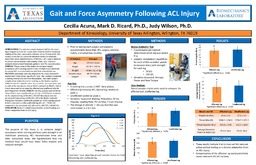
ATTENTION: The works hosted here are being migrated to a new repository that will consolidate resources, improve discoverability, and better show UTA's research impact on the global community. We will update authors as the migration progresses. Please see MavMatrix for more information.
Show simple item record
| dc.contributor.author | Acuna, Cecilia | en_US |
| dc.date.accessioned | 2013-06-11T14:57:25Z | en_US |
| dc.date.available | 2013-06-11T14:57:25Z | en_US |
| dc.date.issued | 2013-06-11 | en_US |
| dc.identifier.uri | http://hdl.handle.net/10106/11749 | en_US |
| dc.description.abstract | The anterior cruciate ligament (ACL) is the most injured ligament in the knee joint and is fundamental for rotational stability of the knee joint and to minimize stress. Tearing of the ACL usually occurs due to a pivot-deceleration motion or traumatic injury that causes hyperextension of the knee. ACL surgery attempts to restore normal function and stability of the knee. However research shows altered kinematic patterns post ACL reconstruction. | en_US |
| dc.description.sponsorship | Wilson, Judy, Ph.D. | en_US |
| dc.description.sponsorship | Ricard, Mark Ph.D. | en_US |
| dc.language.iso | en_US | en_US |
| dc.subject | Anterior Cruciate Ligament | en_US |
| dc.subject | Biodex Isokinetic Test | en_US |
| dc.subject | AMTI Force Plates | en_US |
| dc.title | Gait and Force Asymmetry Following ACL Injury | en_US |
| dc.type | Presentation | en_US |
| dc.publisher.department | Department of Kinesiology, The University of Texas at Arlington. | en_US |
| dc.publisher.department | Biomechanic Laboratory, The University of Texas at Arlington. | en_US |
Files in this item
- Name:
- Acuna Cecilia-Gait and Force ...
- Size:
- 583.2Kb
- Format:
- PDF
- Description:
- PDF
This item appears in the following Collection(s)
Show simple item record


